How to grow onions in a plastic bottle at home
When it’s winter outside, there’s a lack of vitamins and juicy fresh herbs. Many housewives try to grow parsley, cilantro, basil and mint on the windowsill. The most common “home” crop is onions. Many people experimented with germination in childhood by planting an onion in a glass jar with water.
Today, an interesting way of growing onions in a plastic bottle has gained popularity among gardeners.
Is it possible to grow onions in a plastic bottle?
A plastic bottle as a container is perfect for planting onions. To ensure a successful harvest, follow simple recommendations. To determine what size container to use, assess your family's nutritional needs for greens.
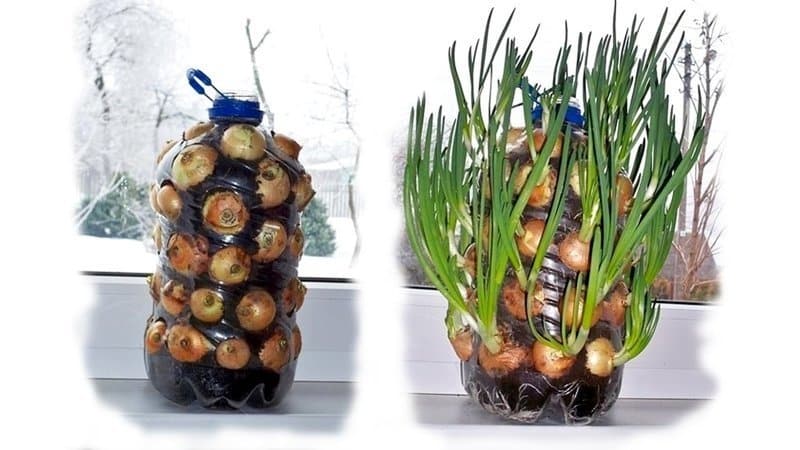
Advantages and disadvantages of this method
The method of planting onions in a bottle has many advantages:
- saving space on the windowsill (a five-liter water bottle holds up to 12 bulbs);
- aesthetic appearance;
- convenient care;
- all plants are evenly illuminated;
- onions are almost not damaged by diseases, since the plants are well ventilated;
- the method is suitable for growing feathers for sale;
- confidence in the environmental purity of the product.
No significant disadvantages of the method were identified. Some gardeners complain about the laboriousness of preparing containers and the complexity glaze, if you do not use a pallet.
Suitable onion varieties
Multi-primed onion varieties with 2-5 growing points are suitable for growing on a windowsill.A cross-section of such a bulb reveals several green dots in the middle. The best varieties:
- Strigunovsky local;
- Ryazansky;
- Danilovsky;
- Rostovsky;
- Arzamas local;
- Chernigovsky 4;
- Stuttgarten Risen.
Except onions, chives, shallots, and varieties of multi-tiered onions are suitable for growing in a bottle. If it is not possible to buy varietal material, use bulbs from the grocery store.
How to grow onions in a plastic bottle
To get started planting onions, prepare containers, planting material and soil. Use a plastic bottle that has previously contained water or another food product, as the chemicals remain on the plastic and get into the bulbs.
Preparatory stage
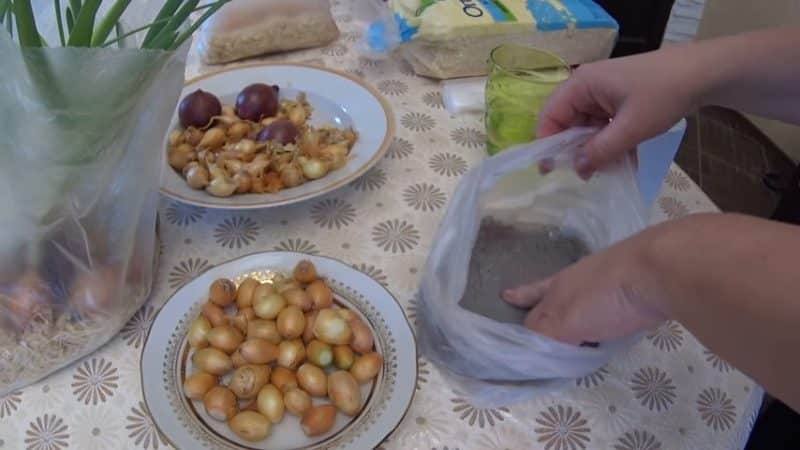
Preparing containers requires patience and accuracy. Preparation technology:
- A plastic bottle with a volume of 5 liters (a smaller volume is more difficult to work with) is washed with water and rinsed with a strong solution of potassium permanganate. This will protect the plants from fungal and bacterial infections.
- The neck with the cork is cut off from the bottle.
- Round holes for the bulbs are cut out on the sides of the bottle in a checkerboard pattern. It is more convenient to do this with nail scissors. The size of the holes depends on the diameter of the selected bulbs.
The volume of a large container allows you to make many holes. The more of them there are, the better the ventilation of the roots and drying of the soil will be.
Preparation of planting material:
- For planting, select strong, healthy bulbs without visible mechanical damage.
- Calibrate the planting material by size. The optimal diameter of the bulbs is 2-4 cm.
- Soak in a pink solution of potassium permanganate at a temperature of 50-55°C for 30 minutes.
- Rinse for 10 minutes in cold water.
- Dry and cut off the dry top by 1-1.5 cm.
To plant in a bottle, you need loose, nutritious soil consisting of two parts humus and one part peat. Onions grow poorly in acidic soil, so dolomite flour is added to the composition at the rate of 300 g/m². If it is not possible to prepare the soil yourself, buy a ready-made substrate for seedlings. Before use, the soil is disinfected by pouring a hot solution of potassium permanganate.
Landing
When everything is ready, you can start planting. To facilitate further care and grow healthy plants, the following planting technology is followed:
- Expanded clay drainage is placed at the bottom of the bottle with a layer of 3 cm.
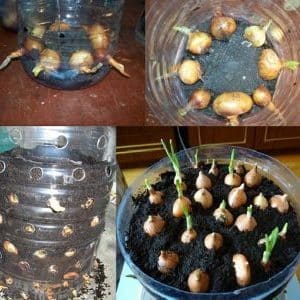
- A 1-2 cm layer of sand is poured on top of the drainage.
- Fill with soil to the level of the lower holes.
- Place the bulbs, carefully inserting their growth points into the holes so that 1/3 of them look out. The soil is poured into the bottle between the bulbs and lightly compacted. The bulbs are used to fill the holes to the top of the bottle.
- The remaining soil is poured on top and the remaining onions are planted horizontally, as in a regular pot.
- The first watering is done in the bathroom. The bottle is placed in a tray or basin and thoroughly poured from the shower head with low pressure of water. When the soil is well saturated with moisture, the containers along with the pallet are transferred to a permanent place.
When the onion begins to grow, from the outside the entire structure will resemble an outlandish cactus or palm tree.
Necessary conditions and care
Onions are unpretentious to growing conditions. It needs warmth, light and water to grow. There is no need for fertilizing, since there is a sufficient supply of nutrients in the soil and bulb.
Lighting
To grow long, succulent feathers, onions need indirect light.The best option for spring growing would be a bright window on the southeast, southwest or west side. In winter, bottles with onions are placed on the south window.
The duration of daylight hours should be 10-12 hours. When growing feathers during the winter months, onions need additional lighting during the dark hours. To ensure that the plants receive sunlight evenly, the container must be rotated 45° every week.
Temperature
For greenery to germinate, it is necessary to maintain 18-20°C. As soon as the first green feathers appear, the temperature is increased to 25°C. Experienced gardeners germinate onions in a cool room (on a loggia, in a bathroom), and then transfer them to a warm place in a permanent place.
Attention! On hot days, if the thermometer has risen to 30°C, shade the onions from sunburn with gauze or white non-woven material.
Humidity
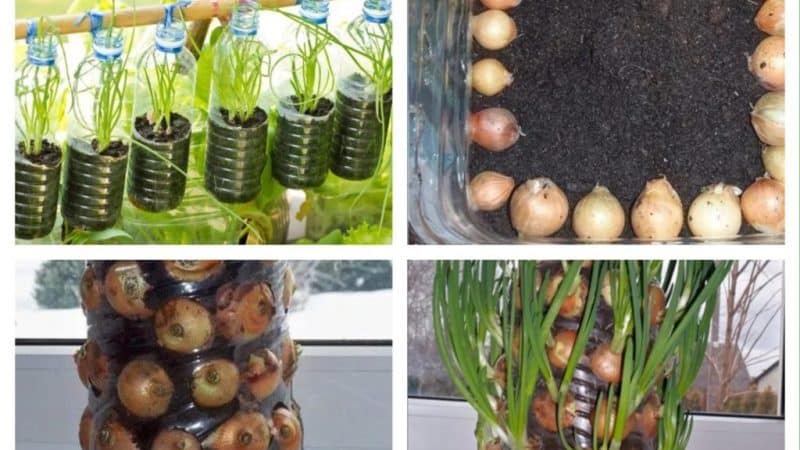
Humidity should not be too high - no more than 70%. In apartment conditions, the air in winter is usually dry, in the range of 60-65%. In very dry air, the bulbs may wrinkle and the tips of the feathers may dry out. To prevent this from happening, the plantings are sprayed daily with warm water from a spray bottle.
Further measures for caring for growing onions come down to periodic watering (rarely, but plentifully), draining excess water from the trays and timely cutting off the feathers. In the first week, the onion devotes all its energy to rooting and does not grow.
Important! To water the onions on time, keep an eye on the top layer of soil. Once it is dry to a depth of 1 cm, water the plants thoroughly.
Possible problems
Caring for onions is easy, but the harvest of greenery is not always successful. The reasons for crop failure can be very different:
- Onion fly - a small insect similar to an ordinary housefly. Its larvae, which eat away the bulb from the inside, are dangerous for plants. An effective way to repel insects is to dust the leaves with ash sifted through a fine sieve.
- Onion moth - a small butterfly that damages the pulp of a leaf by gnawing passages in its tissues. Infection occurs through the soil. It is most common in the Ivanovo and Yaroslavl regions. They destroy it by spraying it with an infusion of red capsicum.
- Root mite - a microscopic insect that infects the roots and bottom of onions. After plants are infected by mites, fungal rots develop as a secondary infection. Mites appear if the room has high humidity and temperatures below 20°C. To solve this problem, treatment with tar is effective: for root watering, take 2 tsp. tar and dissolve in 10 liters of water.
- Fusarium - a fungus that attacks the root system. The bottom of the bulb softens, the roots turn pink and die. The disease is not detected immediately, but after a few days, when the plant stops growing and brown spots appear on the leaves. Diseased plants are thrown out, the remaining healthy ones are transplanted to another soil, the bulbs are treated with the Maxim fungicide - a solution in the ratio of 2 ml of the drug per 1 liter of water.
- Rust attacks onion feathers, causing light yellow or rusty yellow streaks. Subsequently, the leaves dry out completely.
At home, onions in a bottle grow in an average of 2-3 weeks. During this short period of time, plants rarely get sick. The causes of most diseases and the appearance pests – contaminated soil, planting material and heavily waterlogged soil.To avoid problems, treat the soil and bulbs before planting, and do not forget to drain the water from the pan. Repel insects with the help of strong-smelling products - a decoction of garlic, kerosene, dry pepper.
Attention! When growing onions, you cannot use chemical protection measures on the feathers.
Harvest dates and rules
Harvesting begins 15-20 days after planting the bulbs. A feather 20 cm long is cut along the entire circumference of the container. To obtain multiple harvests, cut the onion above the shoot growth point - above 3-4 cm from the bulb.
Advice. Try planting onions in this way with your children - pleasant emotions from the process will be guaranteed.
Tips and tricks
Experienced gardeners and housewives give useful advice to those who first decided to grow onions in an eraser bottle: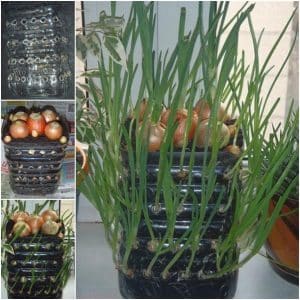
- There is a way to grow onions in bottles without soil - in toilet paper, mineral wool. Beginning gardeners are better off opting for traditional planting in the ground. This makes it easier to monitor the moisture content of the substrate and completely eliminates the need for plant feeding.
- Try to make holes for medium-sized bulbs. For bulbs that are too small, it is difficult to select appropriate bulbs, and large ones will leak water.
- To make the feather grow back faster after cutting, process planting with aloe juice. Chop 2-3 lower aloe leaves and add 250 ml of boiled water. Insist for 24 hours. Bring the volume of liquid to 5 liters and store the solution in a dark place. This natural stimulant can be used on all plants in the house and garden.
Conclusion
Onions grown at home are distinguished by early and friendly harvest. It ripens in 3 weeks. By planting onions in this way, you can cut greens all year round.Its green feathers will create a spring mood and provide the whole family with the necessary vitamins in winter.